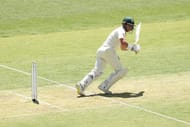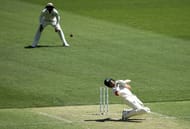
The first international match at the newly built Optus stadium commenced with Australia and India playing out the second Test of the Border-Gavaskar Trophy. The day had an ebb and flow throughout, with Australia arguably getting the better of the exchanges in the end.
Australia’s opening pair stitched together a century stand before Aaron Finch was trapped LBW by Jasprit Bumrah. Marcus Harris continued on his merry way and notched the first fifty of his nascent career, but India hit back in the second session with wickets of the aforementioned duo and Usman Khawaja.
The third session saw the Australians mount a fightback through Shaun Marsh and Travis Head. Once the former’s vigil was ended by Hanuma Vihari, India clawed their way back and eventually got rid of Head with the second new ball.
In the final few overs, Tim Paine and Pat Cummins joined hands and ensured that the Indians didn’t taste any more success. The Aussies ended with a score of 277-6, and on a wicket that has started to play tricks, look in good stead to control the match.
As always, there were a few things that came to light during the course of the day’s play. Through the lens of this article, let's take a closer look at them.
Here are the three things we learned from Day 1 at the Optus Stadium:
#3. Vihari’s bowling can be invested in

India were greeted with a juicy pitch upon their arrival in Perth. With the pitch more or less resembling the outfield’s colour, India decided to go with an all-pace attack; Umesh Yadav was drafted in place of the injured Ravichandran Ashwin, while Vihari took his place as the 6th batsman at the expense of Rohit Sharma.
Though the middle order batsman hasn’t yet had a go with the bat, he has already captured everyone’s attention with the ball.
Vihari is a part-time bowler at best and thus, the team’s decision to not opt for a spinner raised a few eyebrows. However, the lad from Hyderabad ensured that the team didn’t miss the services of a full-time spinner.
He bowled 14 overs and conceded 53 runs. Although he was a tad expensive, his dismissals of Harris and Marsh more than offset the runs given away.
While the end-product was rightly cheered, it was the potential he displayed while bowling that truly caught everyone off-guard.
The off-spinner never really looked out of his depth and quickly worked out his ideal line and length. With the pitch offering bounce, he flattened his trajectory and bowled back of a length, thus making sure the Aussies weren’t able to play easy drives off him.
Moreover, he showed immense poise to not waver from his line or length when the Aussies tried to pressurize him.
Even though the loose delivery reared its ugly head on occasion, there was enough to suggest he had put enough thought into his bowling. If India are thinking of abandoning the five-bowler policy, they might as well invest in ‘Vihari: The Bowler’.
Talk of him becoming a full-fledged all-rounder is still premature, but there is certainly enough bowling talent to make the gamble worthwhile.
#2. Marcus Harris shows he is good enough for the top level

Marcus Harris, the prodigal son, returned to his old stomping ground in Western Australia and immediately looked the part.
Having impressed for Victoria in the Sheffield Shield, the left-hander was expected to make a seamless transition into the Test arena. And even though he couldn’t muster anything of note in the first Test, he seemed to possess all the ingredients to be a successful Test batsman.
At Perth, he translated that talent into runs.
Opening the batting, Harris looked solid during his stay at the crease and was rarely troubled by India’s pacers. The left-hander portrayed extraordinary patience to wait for deliveries in his arc before capitalizing on the loose ones.
The opener looked destined to notch his first international century before an awkwardly bouncing delivery from Vihari sent him back to the pavilion.
Ever since the retirement of Chris Rogers, Australia have failed to settle on a reliable opener. Before his ban, Cameron Bancroft seemed to have made the spot his own. But in the wake of the infamous ‘sandpaper gate’, Australia were left facing the prospect of filling two opening slots, instead of just the customary one.
However, in Harris, they seem to have stumbled upon the right opener. A cross of the likes of Rogers, David Warner and Justin Langer, the left-hander looks set to make a big splash on the international stage.
And with a well-constructed 70 on a challenging pitch, the opener might just have come of age.
#1. 300 might be enough on this pitch

When the Australian board decided to move all future Test matches away from the historic WACA and play them at the new Optus Stadium instead, many believed that the unique flavour of the WACA pitch would be lost forever. But somehow, the curator has managed to serve up a pitch as spicy, if not more.
The pitch at the Optus Stadium looked like a belter in the first session as Harris and Finch got off to a flying start; the pair ensured that India finished wicket-less in the first session. However, the pitch started to spit fire as soon as the second session got underway.
The ball bounced awkwardly off the pacers and the spinners, with Peter Handscomb and Harris falling prey to the unexpected bounce. Moreover, there were also a couple of instances where the ball kept extremely low.
Yet, the biggest talking point of the day came towards the end when a full-length Bumrah delivery bounced over the wicket-keeper’s head and resulted in four byes. Additionally, there was lateral movement on offer with the second new ball, thus opening up another dimension altogether.
With the wicket spitting such fire on the first day itself, it is scary to think how it will pan out in the days to come.
Australia seem to have won a good toss and may just have had the pitch at its best. The home side have already put up 277 on the board, and would hope to add as many as possible tomorrow.
The evidence from Day 1 suggests that a total of around 300 could be the difference-maker. The pitch is certainly not going to get any easier in the days to come, and the batsmen who would’ve felt relieved at not going to the WACA might just have to buckle up for an even sterner test.
Follow IPL Auction 2025 Live Updates, News & Biddings at Sportskeeda. Get the fastest updates on Mega-Auction and cricket news
